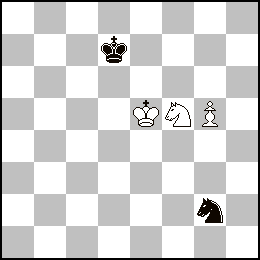 Here again, N plays and draws, the position having been wrongly given as losing.
Here again, N plays and draws, the position having been wrongly given as losing.
I had searched and concluded, too, that the position was losing in view of the following 3 trials.
1:...Ne1? 2:g6 Nd3 3:Ke4 Nc5 4:Kd5 Ne6 5:Ke5 and win, Bs are in zugzwang.
1:...Ke8? 2:g6 Kf8 (what else?) 3:Kf6 and win because on the usual Nf4 defence, the P advances to g7 with check.
Hence the idea of losing a time for the B's so as not to have the K on f8.
1:...Kd8!? 2:g6 Ke8 3:Nh6! (threatening g7) Nh4 4:g7 Ng6+ 5:Kf6 Ne7 6:Ke6 Kd8 7:Nf5 Ng8 8:Kf7 and win.
Obviously, all this is correct, but in the most promising variation, a defence had escaped me. I leave it to the reader to clarify this position.
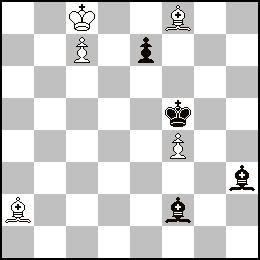 White to play and win.
White to play and win.
I had also searched and not found, but this is not surprising because the study is really difficult (study of a young composer who has already beaten a fellow citizen named Carlsen!).
I had obviously noticed that on 1:Kb7, B's could play neither 1:...Ke4? nor 1:...Kg6? because of 2:f5! and 3:Bb1 which wins, but 1:...Kxf4 is very sufficient to ensure the draw.
In the solution, one suspects that Pc7 will cost Black a Bishop, but to win with two B's against one, it is imperative that W's keep their Pf4, and thus that it is not captured at the first move and not exchanged later.
1:Kd7! Kf6 2:Kd8 now that f4 has not been captured, 2:..Bb6 would lose after 3:Bxe7+ followed by Bd6 or Bg5. 2:..Bc5 (2:..e5? 3:Be7+ and capture of P) 3:Bb1! I indicate the solution up to this position because here an attempt at defence has been suggested by playing with one less B without having eliminated White's P but trying to " cement " the f5 square by 3:..Kf7 4:Bh6 Bb6 5:Bg5! e6?!. This kind of defence is rarely studied because this passive defence is losing and immediately condemned by the analysis engines.
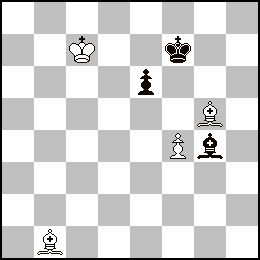 Yet, in a game, how many would know how to win it? The example is therefore interesting, for example as a support for those who teach. The win is obtained by blocking the e5 square, then invading the e7 square with the K by a check on e8 or h5 and finally capturing e6. 6:Kd7 Bxc7 7:Kxc7 Bg4 8:Kd6 Bh3 9:Bh4 Bg4 10:Be1 Bh3 11:Bc3 Bg4 12:Be5 Bh3 13:Bd3 Bg4 14:Bc4 Bf5 15:Be2 Kg6 16:Ke7 Bh3 17:Bc4.
Yet, in a game, how many would know how to win it? The example is therefore interesting, for example as a support for those who teach. The win is obtained by blocking the e5 square, then invading the e7 square with the K by a check on e8 or h5 and finally capturing e6. 6:Kd7 Bxc7 7:Kxc7 Bg4 8:Kd6 Bh3 9:Bh4 Bg4 10:Be1 Bh3 11:Bc3 Bg4 12:Be5 Bh3 13:Bd3 Bg4 14:Bc4 Bf5 15:Be2 Kg6 16:Ke7 Bh3 17:Bc4.
Back in solution. 3:..Bd6 4:Bh6! Bc7 (4:..e5 5:Bg5 Kf7 6:f5 +-) 5:Kc7 e5 6:Bg5 Ke6 7:f5! Bf5 8:Ba2# Respect.
Here are the two exercises for the next session..
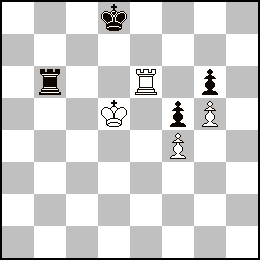 Black to move. Kasparov considers this position winning for White.
Black to move. Kasparov considers this position winning for White.
Exercice 2 :.
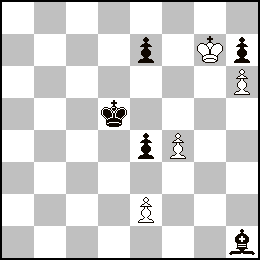
W(4) Kg7 Ph6,f4,e2. B(5) Kd5 Bh1 Ph7,e7,e4. White to play and draw.
.Study of the day.
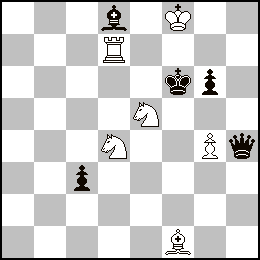 Peter Krug. 2013.
Peter Krug. 2013.
A relatively difficult study (although it was submitted in an indoor solution contest) but one that is very interesting, especially when one has passed the foregrounds.
The Qh8 threat and the Ne5 in grip encourage one to find the key, especially when one refutes the obvious attempt 1:Rf7+? Kxe5 2:Nf3+ Kd6! 3:Nxh4 c2 =
1:Nf7 ! not only deflects the threats but also puts the bK in a cage where it only has to be checked to subdue it.
1:..Be7+ 2:Rxe7 Qxg4 threatens Qc8+ and Qxd4.
So far, the study is quite accessible, but here it gets complicated as several candidate moves present themselves and none seem to impose themselves clearly. Rc7 threatening Rc6 comes to mind but runs into Qxd4.
3:Bh3! Qxh3 4:Rc7 and from here, the reader is really encouraged to look for this study, which can now be found, although it contains surprises that are difficult to imagine in this position.
4:..Qh1 (or g2) 5:Ra7! (one must threaten but also prevent Qa8) Qf1 and now? On a R-move on the 7th, Qa6! is strong.
We have to find a new idea and we obviously don't want to play a N to give squares to the bK.
6:Ra2!! This move comes easily to mind because one thinks that Q must always control a6 but also f2, the f-file being a new access to the bK.
So we say to ourselves that the B's are in zugzwang, but the Qf1 parries the mate and we don't see how the B's would be in zugzwang since they have the Pg.
6:..g5 Is this move penalising for the Bs? To ask the question is to answer it.
I leave it to the reader to finish.
Game of the day.
The Master offers us today a game of the great Shirov against Atalik who had the misfortune to threaten to take the upper hand, which had the effect of waking the beast.
1.e4 e6 2.d4 d5 3.Nc3 Bb4 The Vinawer variation named after its Polish inventor. How is it pronounced? "vin a wer" ? I bet that if he had been French, he would have called himself "wer a vin".
4.e5 Ne7 5.a3 Bxc3+ 6.bxc3 b6 7.Qg4 Ng6 8.h4 prevents Qh4 8...h5 9.Qg3 Ba6 10.Ne2 Rh7 [10...Nc6 11.Nf4]
11.Bg5 Qd7 12.Qf3 Qa4? Looks good, but doesn't realise the potential this leaves. Better was 12...c5! 13.Ng3 Bxf1 14.Kxf1 Qb5+! 15.Kg1 Nc6 16.Qd1 Qc4 17.Ne2 and W's have to fight to equalize]
13.Ng3 Bxf1 14.Kxf1 c5! Because it is necessary to react very quickly in the centre against the Nxh5 threat. 15.Nf5! [15.Nxh5? Nc6!] 15...Qc4+? It is amusing to note that on the 15:...exf5 move, the Qxf5 move would be bad and it is absolutely necessary to play Qxd5. It is only because Black's Q is on c4 and cannot return to d7 that the f5 move becomes good.
[15...exf5?! 16.Qxd5 Nc6 17.e6 Kf8 18.exf7; 15...Qd7! 16.Nd6+ Kf8 17.c4 Nc6 18.cxd5 Nxd4 19.dxe6 Nxf3 20.exd7 Nxg5 21.hxg5 Nxe5 and it is not clear. Extraordinary comment from Shirov: "when I played Nf5, I had this position in mind, but I'm a sucker because I thought it was advantageous and it's not". I advise the reader to look at this position and that of the 15th move (Nf5!) it leaves one dreaming !!]
16.Kg1 exf5 17.Qxf5 Nd7 only move 18.e6 (18.Rh3 Ndf8 19.Rf3!! Nh8 20.e6 f6 21.Re1 cxd4! 22.e7 Nfg6 was also advantageous for Ws, but not easy to play in practice) 18...Nf6 19.Re1 Qxc3 20.exf7+ Kxf7 21.Qe6+ Kf8 22.Rh3 Qxd4 23.Rf3 Nxh4 24.Rf4 Qc3 25.Bxh4 Rh6 26.Re5 Qd2 27.Bxf6 1–0
The fairy-tale third half after class.
It was time to eat. Antony had to leave us to respect the constraints of public transport but Marc and Gregory accompanied us to the table and were able to discover some fairy rules and shine.
Add a comment